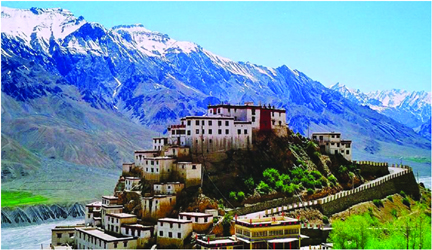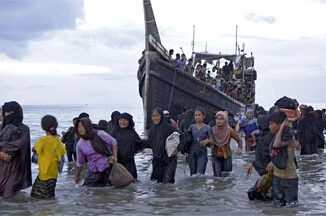
Long winding roads and valleys that present unforgettable glimpses of cold desert and snow-crowned mountains welcome you when you set foot into Spiti Valley. Bordered on all sides by the Himalayas, Spiti Valley, located in Himachal Pradesh, has an altitude of 12,500 feet above sea level, and gets just around 250 days of sunshine in the year, making it one of the coldest places in the country. With the thick Himalayan snow cutting Spiti off from the rest of the country for around 6 months a year, the summer months are the only time Spiti is directly accessible via motorway.
The term Spiti means ‘The Middle Land’, as Spiti Valley separates India from Tibet. Scantily populated, Spiti is an adventure lover’s paradise, with a number of trekking trails that tourists can choose from. All of these treks start from Kaza (Spiti’s capital from where you make your base camp) to various peaks from where you can get panoramic views of the Himalayan mountains. An easy 1.5-kilometre trek along the Spiti River from Dhankar Monastery to Dhankar Lake promises gorgeous views of the villages below. The Dhankar Lake itself is a place where you can sit back and relax amidst the cool mountain air.
How to reach?
Travel by the preferred route from Manali isn’t possible in the snowy winters of Spiti due to closure of Rohtang Jot and Kunzum La pass. Flying to Spiti isn’t an option because there is no airport in Spiti. A few years ago, people thought of Spiti as a summer destination and very few still dare to venture out in the bone-chilling cold of the winters. The only possible way of arriving in Spiti is by the road route from Shimla through NH-22 via Kinnaur and then to Spiti.
The road from Shimla to Kaza is open throughout the year and it is only in case of a major snowfall when the stretch from Tabo to Kaza is closed from a few hours to a few days. It is also to be noted that this route automatically affords gradual acclimatisation if the journey is broken in parts. Rohtang Jot and Kunzum La are officially closed for the season from October 15th and open around May-June.
Shimla is an Inter-State Bus Terminal (ISBT) and has excellent connectivity to the bus stations of Rampur and Reckong Peo in Kinnaur. SUVs and other vehicles can also be rented from Shimla for the entire duration of the trip. The charges for the same may be a bit higher than in the summer months because the engine needs to be kept warm in the cold nights and extra fuel is burnt thereby. Shared taxis also ply sometimes from Rampur to Kaza.’
Places that can and cannot be visited
Some internal roads in Spiti are open in the winter. So it is possible to visit most places in Spiti, even in the stark cold winter. Roads to Demul, Langza, Kibber, Hikkim, Komic, Gue, Pin Valley, Nako and Chango (in Upper Kinnaur), Tabo etc may be open and accessible. It is also possible to visit Lhalung, Dhankar and Losar if the roads are not deemed too dangerous to ply on.
It is important to know that in case of heavy snowfall, there are chances of roads being closed for a day or two or even a week which may hamper your plans. It is better to keep a buffer of a day or two in your plans as snowfall at over 4000 m can cause the road to be shut for vehicular traffic.
The weather is bitterly cold in the high altitude villages of Spiti and the unbearable cold (sometimes -40 degrees Celsius) makes visiting the villages a difficult proposition in the winters.
While travelling, it is advisable to keep the window panes in the vehicle closed so that there is minimal contact with the frigid air.
Remember to always check with locals in Kaza and nearby villages about the prevailing weather and road conditions for the places you are heading to before embarking on a journey in wintry Spiti.
Major attractions in winters
The change in landscape means it is quite possible to think of Spiti as an entirely different land as compared to summers. There are frozen waterfalls, azure blue skies, trees devoid of leaves, pristine freezing rivers in the winter that make Spiti a more beautiful and novel experience.
It is a good idea to first get acclimatised to the bare cold and high altitude of Kaza (3700 m) before exploring the various sites in the region. While coming from the Shimla route, the monastery of Nako coupled with a walk to the frozen or semi-frozen Nako Lake will help in acclimatisation and getting used to the cold. The oldest monastery in India, Tabo Gompa complex can be explored at leisure before making the final run to Kaza.
Apart from these places, there are other noteworthy monasteries in Spiti, including the Sakya Gompa in Kaza, Ki Monastery, Dhankar Monastery and Dhankar Lake, Komic Gompa, Giu Monastery, Lhalung Gompa and Kungri Monastery, all being amazing experiences in the winter. Keep in mind that, depending on the amount of snow, the roads to these places may or may not be open. If the roads are closed, it is possible to trek to these villages on foot in the snow; it is advised not to trek by yourself and have a local guide or villager around.
Major Spiti Valley attraction in the winters is the possibility of walking on the frozen Spiti and Pin rivers; keep in mind that there have been instances of people drowning in the past and any attempts are off the recommended list. A visit to high altitude Spitian village is another major attraction,; you will get to see local life and experience how it goes on in spite of the unbearable freezing temperatures.
Reaching the village of Losar is a big upcoming attraction in Spitian winters. It is the biggest and farthest of all the Spitian villages and is a cultural delight. Locals celebrate festivals and folk dances by singing traditional Spitian songs. To revive the tradition, winters also see young men learn the art of carving Buddhist prayers on mane stones. In Kaza, locals can be seen playing the favourite Spitian game of ‘Cholo’.
The road to Losar is almost unbelievable in the winter and the landscape is covered in a blanket of white. While the poplar trees are bare in Spiti, there may be blossoms of various colours on almond, plum, peach and apricot trees along the route in February/March. Celebrating the festivals of Dechang and Losar is another big attraction in the winters.
Source: Happytrips





Be the first to comment